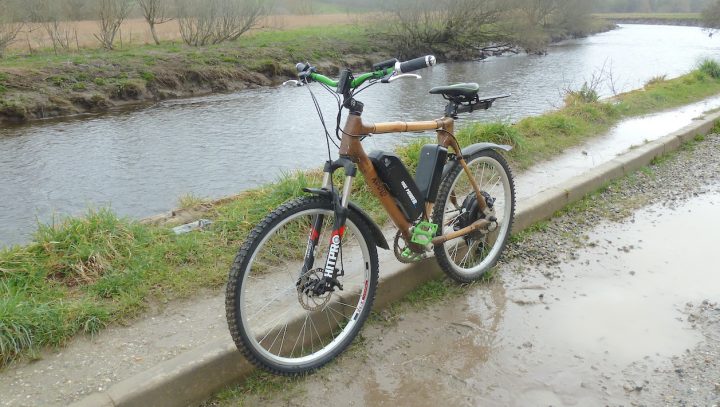It’s the ultimate green machine – a bike which grows in trees.
In an article published on Wheels-Alive on 6 January 2023 on Wheels-Alive I described how the Roots Bamboo Bikes which use sustainable bamboo – ethically-sourced and fairly-traded – for their frames were developed in Ghana and how they came to be sold in Lostwithiel. In that feature I mentioned that a future ‘road test’ might follow in due course.

Fast-forward a few months and my wife Elaine and I were taking a break in Cornwall, during which we were invited to test-ride the bikes in real world conditions.
Three different bikes from the line-up were made available for us to sample, from which we chose and rode two – the ‘Ladies/City’ model and the electric version.
At the outset I closely examined all three bikes, one of which was several years old, and was impressed by their appearance and solid build quality. In talking with Richard Brown, from Electric Bikes Cornwall, and who works closely with Roots Bamboo Bikes, it was clear that every effort is made to make the bikes reliable and durable, by using quality components that will work well, and that will last.
It was soon time to take to the rain-washed roads along the western bank of the River Fowey in Lostwithiel, and to test the bikes on the many gradients in the area.
I should add that it was some years since my wife and I had last ridden a ‘pushbike’, but after a few minutes getting used to the different respective set-ups of each bicycle, we felt at home and at ease with the way that they worked.
In the case of the ‘Ladies/City’ version that my wife Elaine was riding, she found that the bamboo frame provided a comfortable ride quality (more so than with a conventional metal frame), and was light but positive to control. It features conventional Derailleur gears (so-called as they ‘de-rail’ the chain between ratio changes), providing a range of ratios to suit prevailing conditions and gradients. Even on some fairly steep hills of which there are many close to Lostwithiel, she was able to maintain pedal progress.

In my case, on the electric model, I was lucky to have assistance in the form of a motor mounted within the rear wheel hub of the bike, with the battery/charger pack located within the bikes’s main frame. Richard explained that this set-up was preferable to mounting the motor in the vicinity of the pedals at the base of the frame for example.
The electric version can be propelled by pedal power alone, but simply by twisting the right-hand-side handlebar grip, appropriate levels of electrical assistance can be brought into play. This was a great help on the hills we encountered on our circuitous route and made cycling much easier than would have been the case with a traditional pedal cycle.
I too found that the bike’s bamboo frame was resilient and shock-absorbing, and in this case there was additional suspension action provided by the sprung front forks. Even on ‘broken’ surfaces, such as those encountered along the River Fowey bank, progress was positive and comfortable. I found the bike easy to handle as well.
I was also impressed by the instrumentation provided in the form of very clear readouts from a unit mounted on the left-hand-side of the handlebars. These indicated current speed, total mileage for the bike, and power level remaining in the battery pack. All useful information and a great help if using on a daily basis.

The maximum speed allowed by law on an electrically assisted bike is 15 mph, which was easily reached when required. However I was content to cruise along about 8 mph for most of our journeying not least because Elaine, on her ‘ladies’ machine, was having to pedal to maintain that speed! However at times I saw an indicated 12 mph.
Richard estimates that the typical range available on a full battery charge is between 50 and 60 miles, which I reckon would be sufficient for the daily commuting or other transport needs of many people. When required the battery pack can be fully recharged using a conventional main electricity supply at home, and within a reasonable time – this of course depending on how low the battery charge is at the outset.
Approximate example costs of the machines we tried:
‘Ladies/City’ model, frame only: £450, bike frame plus component kit, £940 for Medium size; fully-built (‘Medium’) £1,040.
Electric version, fully-built, £2,150 (£2,130 for the ‘Ladies/City’ variant).
Bob and Jacqueline’s philosophy is simple, “For every Roots Bamboo bike sold, more efforts can go into our numerous projects in Peki, Ghana, creating jobs and future potential for our local community.
“We know that African needs trade more than aid, and we try to promote Ghana-made produce wherever possible.”
VERDICT
These bikes seem well thought-out and very well made, and I would be happy to use one.
I was spoilt by the electric version, which worked well but Elaine said that she very much enjoyed the ‘manual’ Ladies variant too.
According to the on-board indicator on the electric version, the available ‘remaining power level’ hardly dropped even after a busy morning’s use.
Further information:
(Roots Bamboo Bikes can also be found on Facebook and Instagram).

